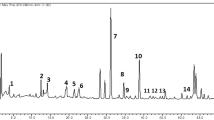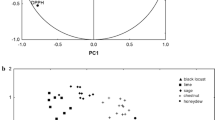Abstract
Antioxidant compounds have the ability to trap free radicals; in honey, this capacity is related to the botanical origin of the sample, and therefore, there has been a growing interest in verifying the floral origin of beehive products and its relation with the polyphenolic compounds with potential antioxidant activity. A FTIR spectrum has been use to discriminate floral origin in Chilean monofloral samples and to predict their antioxidant capacity. Forty-nine honey samples from different geographical zones and botanical origin were classified according to melissopalynology analysis, and total phenolic and flavonoid contents were quantified by spectrophotometric methods. Discriminant analysis showed that Quillay (Quillaja saponaria), Corcolén (Azara petiolaris), and Tebo (Retanilla trinervia) honeys showed similarities related to their common geographical origin, while Ulmo (Eucryphia cordifolia) presents a differentiate behavior. The FTIR spectra were able to predict phenolic and flavonoid content, establishing the potential of spectroscopic tools for quality control in Chilean beehive industry.




Similar content being viewed by others
References
Ahmed S, Sulaiman SA, Baig AA, Ibrahim M, Liaqat S, Fatima S, Othman NH (2018) Honey as a potential natural antioxidant medicine: an insight into its molecular mechanisms of action. Oxidative Med Cell Longev 2018:1–19. https://doi.org/10.1155/2018/8367846
Alissandrakis E, Tarantilis P, Pappas C, Harizanis P, Polissiou M (2011) Investigation of organic extractives from unifloral chestnut (Castanea sativa L.) and eucalyptus (Eucalyptus globulus Labill.) honeys and flowers to identification of botanical marker compounds. LWT-Food Science and Technology 44:1042–1051
Alzahrani HA, Boukraa L, Bellik Y, Abdellah F, Bakhotmah BA, Kolayli S, Sahin H (2012) Evaluation of the antioxidant activity of three varieties of honey from different botanical and geographical origins. Global J Health Sci 4:191–196
Barrera D, Valdés P (2014) Miel chilena: consolidación y nuevos mercados. Oficina de Estudios y Políticas Agracias. Ministerio de Agricultura de Chile. Publicado el 21de julio de 2014
Bridi R, Montenegro G, Nuñez-Quijada G, Giordano A, Morán-Romero M, Jara-Pezoa I, Speisky H, Atala E, López-Alarcón C (2015) International regulations of Propolis quality: required assays do not necessarily reflect their polyphenolic-related in vitro activities. J Food Sci 80(6):C1188–C1195
Bueno-Costa F, Zambiazi R, Wendt B, Clasen F, Padilha W, Teixeira J, Dutra I (2016) Antibacterial and antioxidant activity of honeys from the state of Rio Grande do Sul, Brazil. LWT Food Sci Technol 65:333–340
Ciulu M, Spano N, Pilo MI, Sanna G (2016) Recent advances in the analysis of phenolic compounds in unifloral honeys. Molecules 21(4):451
Corbella E, Cozzolino D (2006) Classification of the floral origin of Uruguayan honeys by chemical and physical characteristics combined with chemometrics. LWT-Food Sci Technol 39(5):534–539
Cornara L, Biagi M, Xiao J, Burlando B (2017) Therapeutic properties of bioactive compounds from different honeybee products. Front Pharmacol 8:412
Corvucci F, Nobili L, Melucci D, Grillenzoni F (2015) The discrimination of honey origin using melissopalynology and Raman spectroscopy techniques coupled with multivariate analysis. Food Chem 169(0):297–304
do Nascimento KS, Sattler JAG, Macedo LFL, González CVS, de Melo ILP, da Silva Araújo E, de Almeida-Muradian LB (2018) Phenolic compounds, antioxidant capacity and physicochemical properties of Brazilian Apis mellifera honeys. LWT Food Sci Technol 1:85–94
Ferreres F, Andrade P, Tomás-Barberán F (1994) Flavonoids from Portuguese heather honey. Z Lebensm Unters Forsch 199:32–37
Gašić UM, Milojković-Opsenica DM, Tešić ŽL (2017) Polyphenols as possible markers of botanical origin of honey. J AOAC Int 100(4):852–861
Heusser C (1971) Pollen and Spores of Chile. The University of Arizona Press, United State of America
Jandric Z, Haughey SA, Frew RD, McComb K, Galvin-King P, Elliot CT, Cannavan A (2015) Discrimination of honey of different floral origins by a combination of various chemical parameters. Food Chem 189:52–59
Kasprzyk I, Depciuch J, Grabek-Lejko D, Parlinska-Wojtan M (2018) FTIR-ATR spectroscopy of pollen and honey as a tool for unifloral honey authentication. The case study of rape honey. Food Control 84:33–40
Leme, L. M., Montenegro, H. R., dos Santos, L. D. R., Sereia, M. J., Valderrama, P., & Março, P. H. (2018). Relation between near-infrared spectroscopy and physicochemical parameters for discrimination of honey samples from Jatai weyrauchi and Jatai angustula Bees. Food Anal Methods, 1–7
Machado De-Melo AA, Almeida-Muradian LBD, Sancho MT, Pascual-Maté A (2018) Composition and properties of Apis mellifera honey: a review. J Apic Res 57(1):5–37
Marticorena C, Quezada M (1985) Flora Vascular de Chile. Editorial Universidad de Concepción, Santiago
Martínez del Río J, Martı́nez Vidal JL, Garrido Frenich A (2013) Economic evaluation of pesticide-residue analysis of vegetables. Trends Anal Chem 44:90–97
Montenegro, G., & Ortega, X. (2013). Innovación y valor agregado en los productos apícolas. Diferenciación y nuevos usos industriales. Recuperado el 11 de febrero de 2015, de Agrimundo: http://www.agrimundo.cl/?publicacion=innovacion-y-valoragregado-en-los-productos-apicolas
Montenegro G, Gómez M, Díaz-Forestier J, Pizarro R (2008) Aplicación de la Norma Chilena Oficial de denominación de origen botánico de la miel para la caracterización de la producción apícola. Cienc Investig Agrar 35(2):181–190
Montenegro G, Santander F, Jara C, Núñez G, Fredes C (2013) Actividad antioxidante y antimicrobiana de mieles monoflorales de plantas nativas chilenas. Boletín Latinoamericano y del Caribe de plantas medicinales y aromáticas 12(3):257–268
Muñoz O, Copaja S, Speisky H, Peña R, Montenegro G (2007) Contenido de flavonoides y compuestos fenólicos de mieles chilenas e índice de antioxidante. Quim Nova 30(4):848–853
Norma Chilena Nch 2981–2005 (n.d.) Miel de abeja. Denominación de origen botánico mediante ensayo melisopalinológico
Oficina de Estudios y Polìticas Agrarias. (2017) Panorama de la agricultura chilena. Ministerio de agricultura, Chile
Pascual-Maté A, Osés SM, Fernández-Muiño MA, Sancho MT (2018) Methods of analysis of honey. J Apic Res 57(1):38–74. https://doi.org/10.1080/00218839.2017.1411178
Popek S, Halagarda M, Kursa K (2017) A new model to identify botanical origin of polish honeys based on the physicochemical parameters and chemometric analysis. LWT-Food Science and Technology 77:482–487
Prelipcean A, Otilia B, Lazăr S (2011) Study on the dynamics of some bioactive elements from bee pollen extracts, vol 55. The International Scientific Symposium of the Faculty of Zootechnics, U.S.A.M.V., Iaşi, pp 238–244
Song SY, Lee YK, Kim IJ (2016) Sugar and acid content of citrus prediction modeling using FT-IR fingerprinting in combination with multivariate statistical analysis. Food Chem 190:1027–1032
Svečnja L, Bubalo D, Baranović G, Novosel H (2015) Optimization of FTIR-ATR spectroscopy for botanical authentication of unifloral honey types and melissopalynological data prediction. Eur Food Res Technol 240:1101–1115
Wen YQ, Zhang J, Li Y, Chen L, Zhao W, Zhou J, Jin Y (2017) Characterization of Chinese unifloral honeys based on proline and phenolic content as markers of botanical origin, using multivariate analysis. Molecules 22(5):735
Zhou J, Yao L, Li Y, Chen L, Wu L, Zhao J (2014) Floral classification of honey using liquid chromatography-diode array detection-tandem mass spectrometry and chemometric analysis. Food Chem 145:941–949
Acknowledgements
We thank Project VRI Interdisciplina 31/2013, Project FIC Regional IDI 30126395-0, CONICYT for Beca Doctorado Nacional and Gastos operacionales N° 21110822, PAI-CONICYT for Beca Tesis de Doctorado en la Empresa N° 781412002, and Project RC 130006, CILIS, by Ministerio de Economía, Fomento y Turismo de Chile.
Funding
Mr. Retamal was financially supported by a fellowship Project Conicyt 7815020014.
Author information
Authors and Affiliations
Corresponding author
Ethics declarations
Conflict of Interest
Ady Giordano declares that she has no conflict of interest. Mauricio Retamal declares that he has no conflict of interest. Edwar Fuentes declares that he has no conflict of interest. Loreto Ascar declares that he has no conflict of interest. Patricia Velásquez declares that she has no conflict of interest. Karina Rodríguez declares that she has no conflict of interest. Gloria Montenegro declares that she has no conflict of interest.
Ethical Approval
This article does not contain any studies with human participants or animals performed by any of the authors.
Informed Consent
Not applicable.
Additional information
Publisher’s Note
Springer Nature remains neutral with regard to jurisdictional claims in published maps and institutional affiliations.
Rights and permissions
About this article
Cite this article
Giordano, A., Retamal, M., Fuentes, E. et al. Rapid Scanning of the Origin and Antioxidant Potential of Chilean Native Honey Through Infrared Spectroscopy and Chemometrics. Food Anal. Methods 12, 1511–1519 (2019). https://doi.org/10.1007/s12161-019-01473-z
Received:
Accepted:
Published:
Issue Date:
DOI: https://doi.org/10.1007/s12161-019-01473-z




